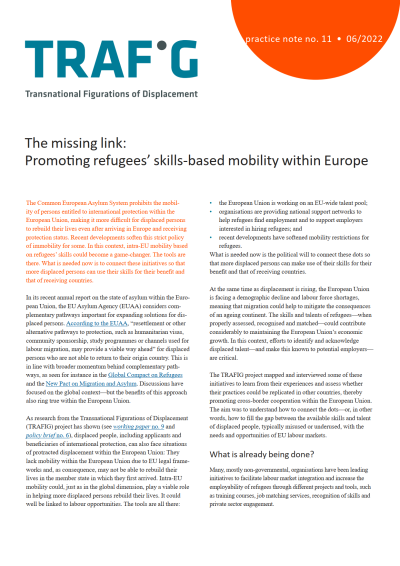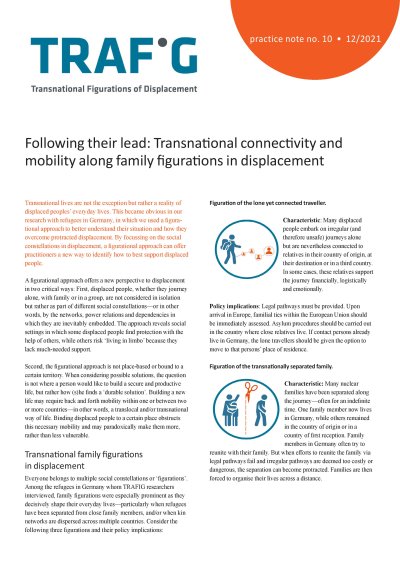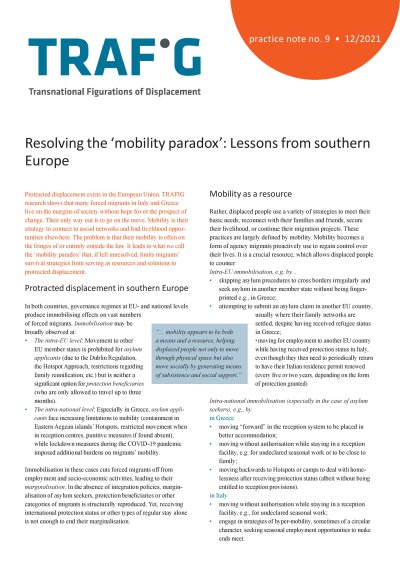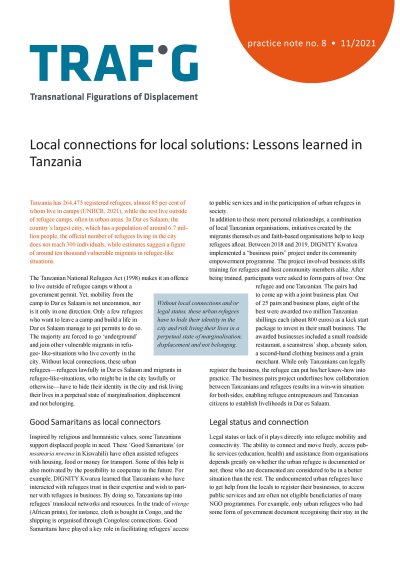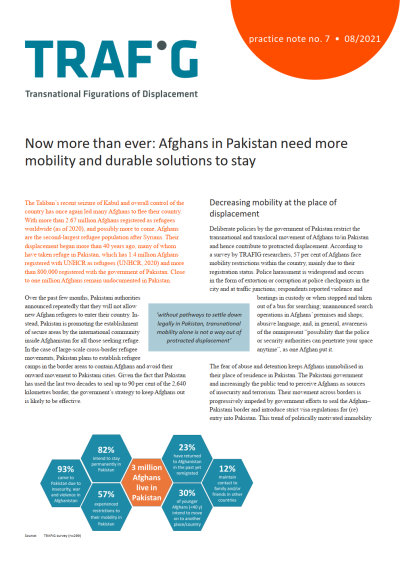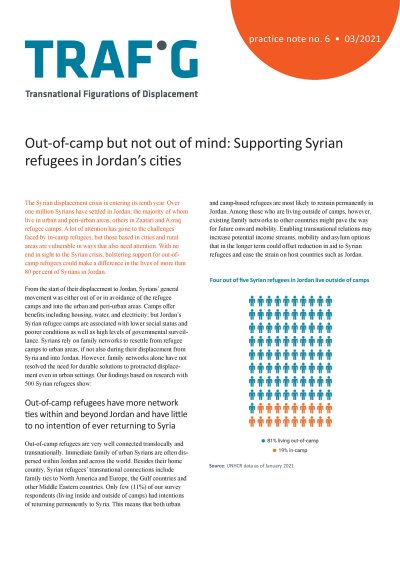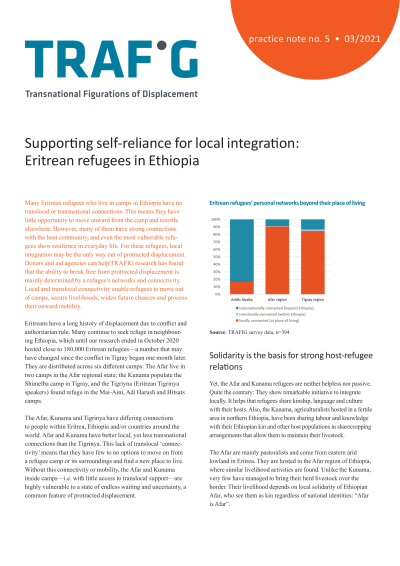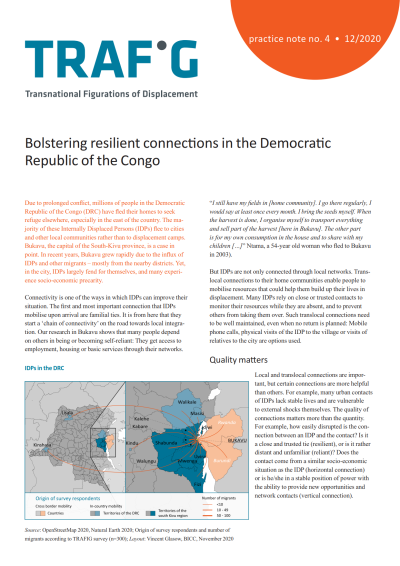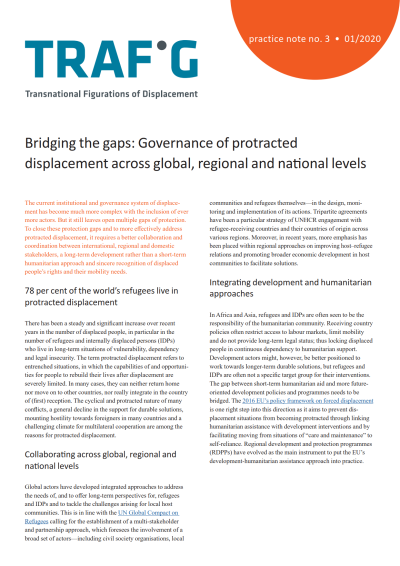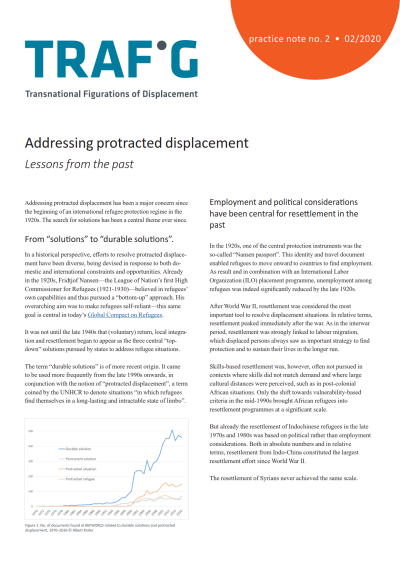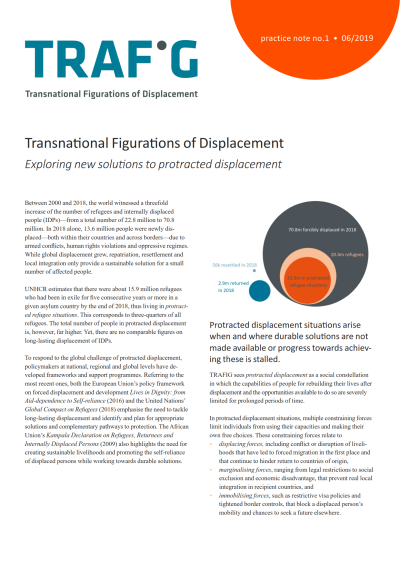Practice Notes
TRAFIG practice note no. 12
In the shoes of a Congolese refugee:
Online game helps to understand urban refugees' legal struggles
The TRAFIG team developed an interactive story-based online simulation to sensitise practitioners and the public to the multiple challenges urban refugees in Dar es Salaam face. Feedback workshops with refugees, government officials and other local stakeholders in Tanzania and with scholars and students in the Netherlands helped to refine the game and draw key lessons from the method.
TRAFI... Read more
TRAFIG practice note no. 11
The missing link
Promoting refugees’ skills-based mobility within Europe
The Common European Asylum System prohibits the mobility of persons entitled to international protection within the European Union, making it more difficult for displaced persons to rebuild their lives even after arriving in Europe and receiving protection status. Recent developments soften this strict policy of immobility for some. In this context, intra-EU mobility based on refugees’ skills could become a game-changer. The tools are there. What is needed now is to connect these initiatives so that more displaced persons can use their skills for their benefit and that of receiving countries. Read more
TRAFIG practice note no. 10
Following their lead
Transnational connectivity and mobility along family figurations in displacement
Transnational lives are not the exception but rather a reality of displaced peoples’ everyday lives. This became obvious in the TRAFIG research with refugees in Germany, which was based on a figurational approach to better understand their situation and how they overcome protracted displacement. By focussing on the social constellations in displacement, a figurational approach can offer practitioners a new way to identify how to best support displaced people.
Everyone belongs to multiple social constellations or ‘figurations’. In the TRAFIG research in Germany, which is presented in TRAFIG working paper no. 10, family figurations of displaced persons were of particular importance, as decisively shape their everyday lives—particularly when refugees have been separated from close family members, and/or when kin networks are dispersed across multiple countries. Read more
TRAFIG practice note no. 9
Resolving the ‘mobility paradox’ - Lessons from southern Europe
available in English, Italian, Greek
Protracted displacement exists in the European Union. TRAFIG research shows that many forced migrants in Italy and Greece live on the margins of society without hope for or the prospect of change. Their only way out is to go on the move. Mobility is their strategy to connect to social networks and find livelihood opportunities elsewhere. The problem is that their mobility is often on t... Read more
TRAFIG practice note no. 8
Local connections for local solutions: Lessons learned in Tanzania
Available in English and Swahili
Dar es Salaam is Tanzania’s largest city with a population of around 6.7 million people. Amongst them are approximately ten thousand vulnerable migrants who find themselves in refugee-like situations. Most of these vulnerable migrants are forced to live ‘underground’ because they do not have a government-issued permit to live outside of refugee camps. They nevertheless take their chances to bu... Read more
TRAFIG practice note no. 7
Now more than ever
Afghans in Pakistan need more mobility and durable solutions to stay
The Taliban’s recent seizure of Kabul and overall control of the country has once again led many Afghans to flee their country. With more than 2.67 million Afghans registered as refugees worldwide (as of 2020), and possibly more to come, Afghans are the second-largest refugee population after Syrians. Their displacement began more than 40 years ago, many of whom have taken refuge in Pakistan, which has 1.... Read more
TRAFIG practice note no. 6
Out-of-camp but not out of mind
Supporting Syrian refugees in Jordan’s cities
Available in English and Arabic
The Syrian displacement crisis is entering its tenth year. Over one million Syrians have settled in Jordan, the majority of whom live in urban and peri-urban areas, others in Zaatari and Azraq refugee camps. A lot of attention has gone to the challenges faced by in-camp refugees, but those based in cities and rural areas are vulnerable in ways that also need attention. With no end... Read more
TRAFIG practice note no. 5
Supporting self-reliance for local integration
Eritrean refugees in Ethiopia
Many Eritrean refugees who live in camps in Ethiopia have no translocal or transnational connections. This means they have little opportunity to move onward from the camp and resettle elsewhere. However, many of them have strong connections with the host community, and even the most vulnerable refugees show resilience in everyday life. For these refugees, local integration may be the only way out of protracted displ... Read more
TRAFIG practice note no. 4
Bolstering resilient connections in the Democratic Republic of the Congo
Available in English and French
Due to prolonged conflict, millions of people in the Democratic Republic of the Congo (DRC) have fled their homes to seek refuge elsewhere, especially in the east of the country. The majority of these Internally Displaced Persons (IDPs) flee to cities and other local communities rather than to displacement camps. Bukavu, the capital of the South-Kivu province, is a case in point. In recen... Read more
TRAFIG practice note no. 3
Bridging the gaps
Governance of protracted displacement across global, regional and national levels
The current institutional and governance system of displacement has become much more complex with the inclusion of ever more actors. But it still leaves open multiple gaps of protection. To close these protection gaps and to more effectively address protracted displacement, it requires a better collaboration and coordination between international, regional and domestic stakeholders, a long-ter... Read more
TRAFIG practice note no. 2
Addressing protracted displacement
Lessons from the past
Addressing protracted displacement has been a major concern since the beginning of an international refugee protection regime in the 1920s. The search for solutions has been a central theme ever since.
In a historical perspective, efforts to resolve protracted displacement have been diverse, being devised in response to both domestic and international constraints and opportunities.The term “durable solutions” is of more recent origin... Read more
TRAFIG practice note no. 1
Exploring new solutions to protracted displacement
According to the UNHCR’s latest estimates 15.9 million people are living in protracted refugee situations at the end of the year 2018. This corresponds to more than three-quarter of all refugees. Resolving protracted refugee situations is a fundamental global challenge, yet progress remains stalled.
TRAFIG aims to contribute to the development of alternative solutions to protracted displacement. This practice note summarizes our approach. Read more


